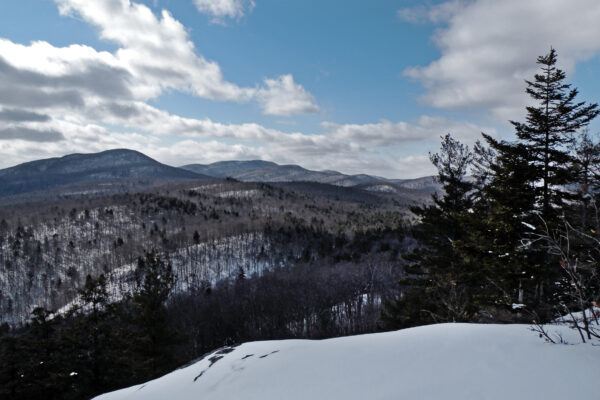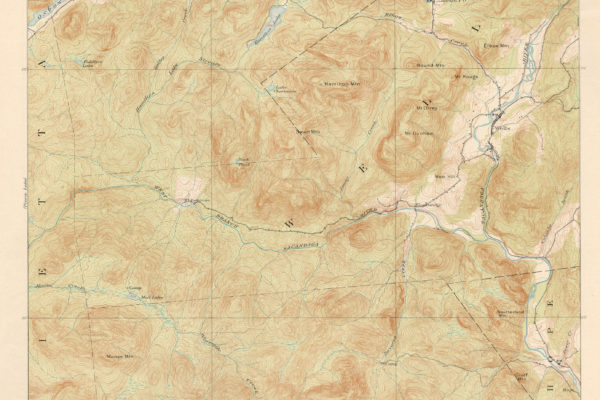On Saturday, November 10, the principal organizers of Adirondack Wilderness Advocates gathered in southern Hamilton County. Snow had fallen the previous night, blanketing the forest in wet, new snow; and fleets of Niagara Mohawk trucks were roaming the back roads to mend disconnected utility lines and restore power to much of the county. The blackout extended to Hope, the small hamlet on the Sacandaga River where we had secured the Town Hall as a meeting space. We were a small group of just seven people, and we gathered with no publicity or fanfare; but it was a momentous event, because it represented the first regular meeting of the new board of directors for our organization.
If you are familiar with the history of AWA, you already know that we formed a little more than two years ago to advance a wilderness classification for the Boreas Ponds Tract. Originally we were just three guys uniting in a common cause, meeting for the first time on the summit of Ragged Mountain. We were motivated to create this new, informal group because we saw a process about to unfold in which the public’s desire for wilderness would otherwise not be fully voiced.
As soon as we announced our presence in September 2016 we began to attract attention, especially from younger wilderness enthusiasts who were struggling to identify with the message espoused by other groups. Attendance at our informal planning meetings steadily grew, and our pro-wilderness mission resonated with a large portion of the public. Even with no staff, no budget, and no professional representation, it was clear we were making an impact.
It also became clear by 2017 that AWA could be more than just a single-issue campaign. In a short amount of time we had established a positive reputation, especially for our ability to generate public interest in the wilderness cause—or perhaps more accurately, demonstrate that the public’s desire for wilderness preservation had not diminished. So how else might we contribute to shaping the future of the Adirondacks? What were our strengths, and what could we offer to the discussion that hadn’t been seen before?
Our informal governance structure—in which we met whenever we felt we had something important to discuss, often in local restaurants or in someone’s living room—had served us fine when our sole concern was generating turnout for the Boreas Ponds hearings, but it was proving less effective as we branched into new areas of concern. If we were going to continue, we needed to get our act together.
So in May 2018, six of us met at a member’s home in Saranac Lake and decided that we wanted AWA to endure, and to make that happen we needed to formally organize and create a board of directors. This would be the first step toward our ultimate goal of filing for 501(c)(3) status and growing to become a respected grass-roots organization leading the wilderness discussion in the Adirondacks.
These are the events that led up to our first official board meeting in Hope. In some ways it didn’t feel like a first, as all of the inaugural board members were veterans of the Boreas campaign. But it was a crucial first step in our transformation from an informal band of activists to an established entity with the capability to demonstrate that wilderness is in fact a mainstream idea, embraced and cherished by many New Yorkers.
As the board’s chairman, I chose Hope as our first meeting location not so much because of the symbolic nature of the name, but because the township lies just across the Sacandaga River from the Silver Lake Wilderness, which played a key role in one of our biggest discussions of the day. Local government had been gracious enough to lend us the use of the space, but Mother Nature was less cooperative; because of the blackout, this first board meeting will also go down in our group’s history as the one in which we had no heat or electricity.
So OK, not everything went quite according to plan, but it was still a constructive event. Prior to the start of the meeting, several board members met near the Lake Algonquin dam in Wells to embark on a visit to Whitehouse, a road-accessible camping area located deep within the Silver Lake Wilderness. The November snow was wet and unplowable, but we navigated the entire length of the road and enjoyed the short walk to the Northville-Placid Trail suspension bridge over the West Branch Sacandaga River.
Six of the eight board members, as well as one guest, then gathered at the Town Hall in Hope, where for the course of several hours we discussed the status of our organization and some of the issues where we think we can assume leadership positions. These are projects that are still in development, so I don’t want to get into the details of the agenda right now; I’m sure you’ll hear about them soon enough anyway. The point I want to communicate is that despite the cold, and despite the fact there was no electricity to power my digital projector, our discussion was fruitful. It was a solid meeting.
By the end of the afternoon, we left Hope invigorated with the new ideas we had generated. We also left with a sense of purpose. As the leaders of this new organization, still in its formative stage, it is our responsibility to build something that people will want to support. We still have a long trail to follow, but Hope was an important step in the right direction.
2018 AWA Board Members
- Bill Ingersoll, Barneveld, NY – Chair
- Brendan Wiltse, Saranac Lake, NY – Vice-Chair
- Pete Nelson, Keene, NY – Secretary
- Craig McGowan, Rochester, NY – Treasurer
- Ari Epstein, Schenectady, NY
- Janelle Hoh, Saranac Lake, NY
- Tyler Socash, Keene, NY
- Kayla White, Lake Placid, NY



